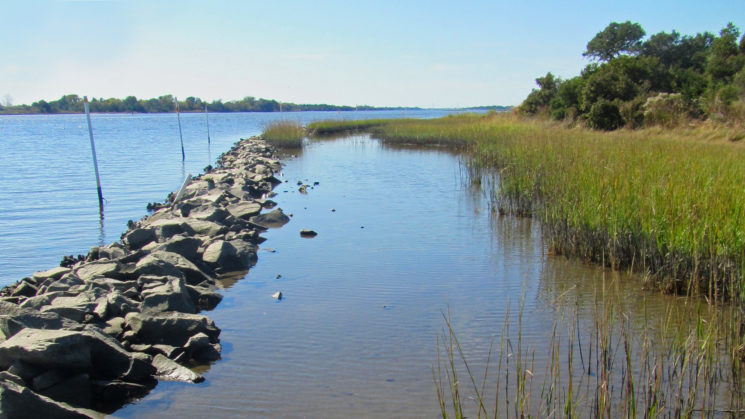
Above: Morris Landing, a North Carolina Coastal Federation living shoreline site in Holly Ridge, courtesy of Carter Smith.
As coastal North Carolina ecosystems rebound from Florence and Michael, new research shows that “living shorelines” helped to make saltmarshes more resilient to Hurricane Matthew.
Researchers have long known that nature-based solutions have the potential to restore critical ecosystems, enhance coastal sustainability and increase resilience to natural disasters. Living shorelines, for example, bring ecological benefits that include maintaining coastal saltmarsh and enhancing the value of coastal habitats for fish and crustaceans.

Carter Smith, courtesy of UNC Research.
However, scientists had not measured structures like living shorelines during hurricanes to gauge how well they could buttress ecosystems when compared with traditional hardened shorelines. Thanks to a Sea Grant Coastal Policy Fellowship, Carter Smith, a graduate student at the UNC Institute of Marine Sciences, investigated a common living shoreline design that combines restored salt marsh with a low-rising breakwater constructed of granite rocks that run parallel to shore.
“Our team’s results revealed that these rock sill living shorelines were more resilient to the impacts of Matthew than either traditional hardened shorelines or natural marshes,” Smith says. “The living shorelines demonstrated better resistance to landward erosion, and they additionally maintained landward elevation over the entire two-year study period, without requiring any repair before, during or after the hurricane.”
Saltmarsh vegetation was never present at any hardened shorelines in her project, Smith adds, and over the course of the two-year study, the edge vegetation at natural marshes was almost completely lost. By contrast, at the inside edge of living shorelines the stem densities increased for saltwater cordgrass (S. alterniflora), an important ecosystem engineer.
“This suggests that living shorelines can help sustain coastal saltmarsh habitats over time when saltmarsh might otherwise be lost,” she says.